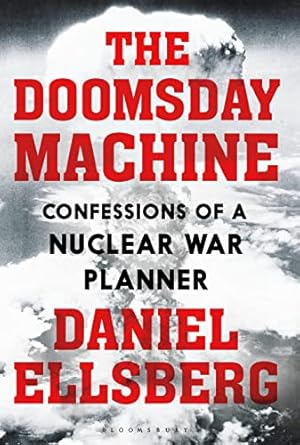
Prime Free Trial
Unlimited Premium Delivery is available to Amazon Prime members. To join, select "Yes, I want unlimited Premium Delivery with Amazon Prime" above the Add to Basket button and confirm your Amazon Prime free trial sign-up during checkout.
Prime members enjoy:- Free delivery of millions of products
- Instant streaming of thousands of films and TV episodes (with limited ads)
- Free in-game content and secured photo storage

Download the free Kindle app and start reading Kindle books instantly on your smartphone, tablet or computer – no Kindle device required.
Read instantly on your browser with Kindle for Web.
Using your mobile phone camera - scan the code below and download the Kindle app.

The Doomsday Machine: Confessions of a Nuclear War Planner Paperback – 24 Jan. 2019
Purchase options and add-ons
- Print length432 pages
- LanguageEnglish
- PublisherBloomsbury Publishing PLC
- Publication date24 Jan. 2019
- Dimensions12.9 x 2.7 x 19.8 cm
- ISBN-101408889285
- ISBN-13978-1408889282
Customers who viewed this item also viewed
Safety and product resources
Issue loading the information
- Product safety imagesManufacturer informationResponsible person
Issue loading the information
Issue loading the information
Issue loading the information
Product description
About the Author
Product details
- Publisher : Bloomsbury Publishing PLC (24 Jan. 2019)
- Language : English
- Paperback : 432 pages
- ISBN-10 : 1408889285
- ISBN-13 : 978-1408889282
- Dimensions : 12.9 x 2.7 x 19.8 cm
- Best Sellers Rank: 71,643 in Books (See Top 100 in Books)
- 908 in Sociology
- 4,256 in Biographies & Memoirs
- 55,243 in English Books
- Customer reviews:
Customer reviews
Customer Reviews, including Product Star Ratings, help customers to learn more about the product and decide whether it is the right product for them.
To calculate the overall star rating and percentage breakdown by star, we don’t use a simple average. Instead, our system considers things like how recent a review is and if the reviewer bought the item on Amazon. It also analyses reviews to verify trustworthiness.
Learn more how customers reviews work on AmazonTop reviews from other countries
Recommended reading; The Devil's Chessboard by David Talbot, JFK And the Unthinkable by Robert J. Douglas, Super Imperialism 3rd Edition by Michael Hudson, Dark Money by Jane Mayer, and Democracy in Chains by Nancy MacLean...
The first two books lay out the horrific control over the U.S. the CIA.... It will give you a thorough understanding of the true greatness of JFK's visionary enlightenment towards nations living in peace without nuclear threat.... MIC could not have that. They strove to make sure of that.
The remaining three books will give you the greed that drives the Military Industrial complex that drives us ever closer to the complete insanity of world ending nuclear war....
Ellsberg lays the remainder of that threat, out in horrific, articulate detail.....
Ellsberg will be remembered for releasing The Pentagon Papers about the Vietnam War; but, at the same time that he was copying The Pentagon Papers, Ellsberg also copied secret records relating to U. S. nuclear strategy. He planned to release these as well—but these copies apparently were inadvertently buried under a condominium. In their absence, Ellsberg wrote this volume, over a period of years, based on the notes he prepared as a consultant with the RAND Corporation, his experiences as an adviser to top government officials, declassified documents, and various secondary works.
In 1961, the Joint Chiefs of Staff estimated that a U.S. nuclear attack would result in 600,000,000 deaths, of which 100,000,000 would be in nations outside of the USSR and China (the principal targets). Ellsberg was horrified by these estimates, which represented an “evil beyond any human project ever.” When atomic bombs gave way to much more lethal hydrogen bombs, planners balanced the equation, not by reducing the number of bombs, but by increasing the number of projected casualties.
A decade after the JCS presented these casualty figures, scientists, whose plans to study the planet Mars, had been disrupted by dust storms that obscured that planet, turned their attention to the effects of the resulting dust cloud, and then to the effects of similar dust clouds on the earth. Eventually, investigators calculated that the smoke and dust from large numbers of nuclear blasts might obscure the sun, causing drastic drops in temperature—a “nuclear winter” that would paralyze agricultural production and perhaps doom humanity to follow the path taken by the dinosaurs when an asteroid struck the earth, blocking out the sun in a similar manner. (Ellsberg does not mention the possibility that nuclear warfare might damage the ozone, and expose the earth to dangerous radiation from the Sun.) Opinions differ regarding the probability and severity of a nuclear winter, but it is striking that for decades no one undertook a major effort to study the possible effect of nuclear explosions apart from their damage to target areas. Ellsberg notes that, in their quest to develop the bomb, scientists were willing to risk the slim chance that an atomic explosion might ignite the earth’s atmosphere.
The U.S. and the USSR based their battle plans on the assumption that Europe would be the major battlefield. The Soviets, with massive conventional forces in place, and with interior lines of communication, would have advantages in a conventional war that the NATO countries could not hope to match. Hence, the USSR relied on conventional forces, and required only sufficient nuclear weapons to deter a U.S. nuclear attack. The U.S., on the other hand, unable to match the Soviets in a conventional war, would turn much more quickly to nuclear options. Put another way, Eisenhower chose to rely on nuclear weapons because an attempt to match Soviet conventional forces in Europe would be too costly. Even before the USSR had nuclear weapons, the Strategic Air Command was prepared to drop atomic bombs on the Soviet Union. The Americans and the Soviets both regarded their nuclear strategies as defensive; but for the U.S. defensive strategy involved first use of nuclear weapons. Ellsberg does not tell us if anyone considered whether Europe would suffer more from victory in a nuclear war or defeat in a conventional war.
Since U.S. policy makers regarded all the Communist countries as a single monolithic bloc, nuclear war plans contemplated a massive simultaneous attack on both the USSR and China, without regard to the proximate causes of any war. Contemplating the deployment of thousands of warheads, planners developed intricate schedules, so the blast from one nuclear warhead would not prevent the delivery of nuclear warheads on other targets. This necessitated timing the detonation of each warhead down to the minute and even the second. Considerable time was required to work out this bombing schedule, so it could not be modified to fit unanticipated situations. Consequently, planners could not make last minute revisions to limit an attack to either the USSR or China. Thus, China would be attacked, regardless of whether it had done anything to provoke an attack. Moreover, it was extremely improbable that this plan could be implemented as planned, since it took no account of communication problems or meteorological conditions. As with many military plans, planning was precise, but execution would inevitably be less so.
Faced with the contingency of nuclear war, planners considered the possibility of launching a successful first strike that would eliminate the opponent’s ability to retaliate. This involved, on the one hand, actually launching such an attack, and, on the other hand, ensuring that no first strike attack could prevent a retaliatory response (second strike). This book takes its title from the movie, “Dr. Strangelove,” in which the Soviets had developed a retaliatory system (“Doomsday Machine”) that would automatically blanket the earth with fatal radioactivity in the event of a nuclear attack on the USSR. But apart from such a system, both the U.S. and the USSR delegated to subordinate officers the ability to launch nuclear attacks on their own, without authorization from central headquarters, if they believed their country was undergoing a nuclear attack. This situation stimulated Ellsberg’s interest in preventing unauthorized launches, and in limiting initial nuclear attacks to military targets, thus preserving the other side’s command and control systems, which might be able to limit a nuclear war once it began. He considered it essential that there would be a government with which to negotiate, a government that could call an end to nuclear attacks. But Ellsberg concedes that it would be difficult to limit an attack to military targets, and communication between belligerents might be very slow, or impossible. Military officers distrusted central direction, especially when prompt action seemed essential; hence, in practice, some decisions about nuclear attacks were delegated down to individual pilots and submarine commanders, and many officers developed ways to circumvent prescribed “fail-safe” procedures.
During World War II, several countries were carrying on atomic research. The Germans had been leaders in nuclear research before the Second World War; a Russian nuclear research program had begun in 1939 (with the advent of the Manhattan Project, American scientists stopped publishing articles on related subjects, causing Russian scientists to suspect that a U.S. nuclear program was in progress). And the Japanese began their program in 1941—a Japanese physicist was perhaps the first to envision a hydrogen bomb. Thus, the assumption of some American planners that the U.S. could maintain a monopoly on nuclear weapons for a considerable time was mistaken. Nonetheless, some postwar policies rested on this assumption.
Ellsberg explains how the threat of nuclear weapons was often invoked for diplomatic purposes. He lists 25 “nuclear crises” in which the U.S. threatened or considered tactical or strategic nuclear strikes. He deals with Hiroshima, “Brinkmanship,” and the Berlin Crisis. But he writes at greater length about the Cuban Missile Crisis. Ellsberg seems to agree with Robert McNamara that this was really a political crisis rather than a military one. But, in fact, the threat of nuclear war was much greater than Americans realized at the time. U.S. leaders focused on the threat posed by strategic missiles in Cuba; they were unaware that the Soviets had deployed tactical nuclear weapons there and planned to employ them against a possible U.S. attack (which American military leaders wanted to launch). Nor were they aware that Soviet submarines in the Caribbean were armed with nuclear tipped torpedoes. U.S. surface vessels made threatening moves against these submarines, and it was only the decision by perhaps half a dozen Soviet naval officers that prevented a nuclear attack on U.S. navy vessels, which could have triggered a major war. A disconcerting epilogue to this episode is that, after they returned to the USSR, these Soviet officers were sharply criticized for failing to fire their nuclear torpedoes.
Ellsberg’s assessment of American leaders and their policies is interesting. He discusses the decisions of Truman, Eisenhower, John Foster Dulles, Kennedy, Johnson, and Nixon. He describes how Nixon wanted to use nuclear weapons in Vietnam, and speculates that Nixon ordered the White House “plumbers” to break into the Brookings Institute to steal documents related to this plan.
This book focuses on the years in which Ellsberg was closely associated with nuclear weapons policy, so it does not describe subsequent events. Its stress is on deployment and control of nuclear weapons. To some extent, it neglects such other developments as anti-ballistic missile systems and civil defense measures. It does not deal with the Partial Nuclear Test Ban Treaty (1963), or significant diplomatic efforts such as those leading to the Anti-Ballistic Missile Treaty (1972), the Strategic Arms Limitation Treaty (1972), and the Intermediate-Range Nuclear Forces Treaty (1987). Ellsberg hopes to eliminate nuclear weapons entirely; but such arms control agreements constitute initial steps toward reducing the nuclear threat.
Carl Sagan has said, “The nuclear arms race is like two sworn enemies standing waist deep in gasoline, one with three matches, the other with five.” The one with “only” three feeling two or three more matches would bring security. A nuclear war to “protect” Western Europe might actually destroy it. And the country that launched a successful first strike and eliminated its adversary’s nuclear arsenal might be doomed by a nuclear winter produced by its own missiles. Many years ago, a prominent American politician said that, if only two persons survived a nuclear war, he would want them to be living in North America. That, perhaps, would be victory in a nuclear war. The 35 pages of notes in the back matter indicate the sources on which Ellsberg relied. The volume has a good 24-page index—strange to say, it contains only one entry for “madness.”
Soine chilling facts.
But goes on and on forever on the same lines
Perhaps lacked the time to make it shorter
Good read anyway




